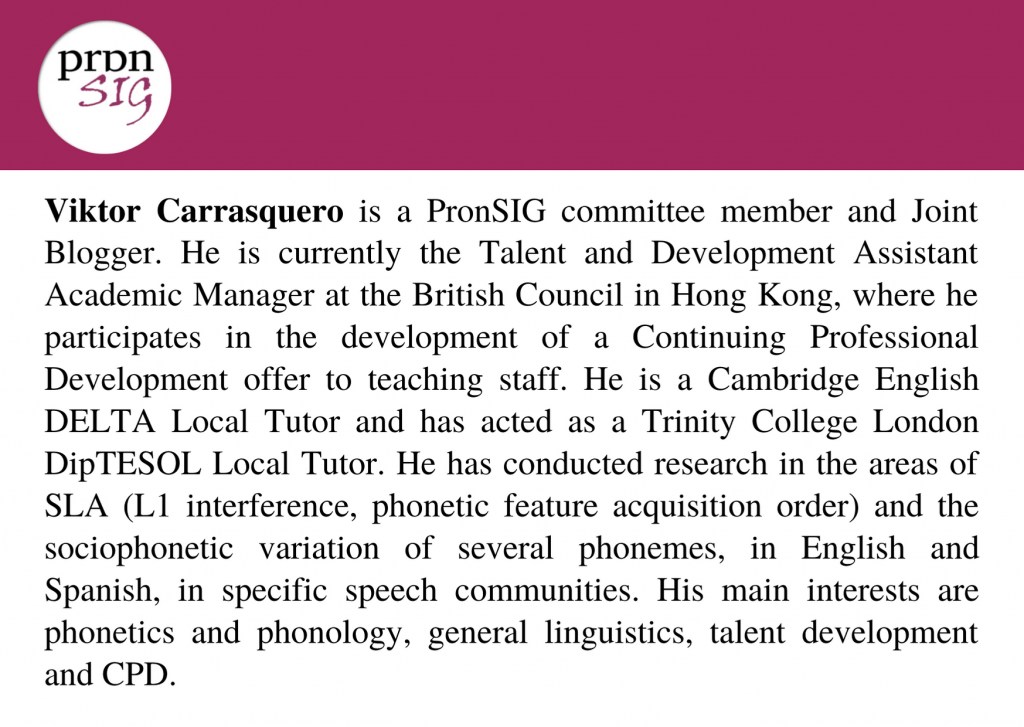By Viktor Carrasquero
Introduction
I have taught phonics to children and adults. In courses of this type, learners become aware of spelling patterns, and how these represent sounds; this is one of the principles of reading. In phonetics, spelling is almost always irrelevant, given that its primary concern is speech sounds. In teaching, however, we need to bridge the gap between our understanding of the sounds of English and our knowledge of spelling. In my own training as a teacher, the lack of a one-to-one correspondence between sounds and letters has been an ubiquitous maxim, usually unearthed when studying the phonetic alphabet. The English Pronouncing Dictionary puts it eloquently: “the spelling of English is so unreliable as a guide to pronunciation that we need something better [i.e., phonemic transcription]” (Roach, et al., 2011: vi). The latest PronSIG webinar with Rosane Silveira, Friend or foe? – Orthography in pronunciation learning and teaching, has come as a breath of fresh air, as she reminds us that the spelling of English is not altogether unpredictable. Thus, in this post, I will briefly discuss 1) the origins of the inconsistency of the spelling of English; 2) some of Silveira’s points; and 3) some of my own suggestions.
The mysterious ways of the spelling of English
Think of English as a tapestry, whose rich history can be seen and heard. People from diverse origins have woven their languages’ sounds into what became English; the influences that enriched its sound system, heightening its complexity. Such evolution is natural, just as spoken language is innate. Conversely, writing is not natural, it is conventional; connections between sounds and letters are arbitrary. English spelling has gone through many standardisation attempts, since even before the early times of the printing machine, when different printers had idiosyncratic ways of representing sounds graphologically, which is still evident in the great sound-letter inconsistency of the language (see Coulmas 1989 and 1996 for an extended discussion on the evolution of writing systems). This has led many experts in didactics and spelling to argue that spelling is not a reliable predictor of pronunciation (see Carney 2012:11 for a discussion of the negative potential of “making spelling an authority for pronunciation”).
Silveira’s perspectives
Silveira’s argument is simple and compelling. She explains that while some authors see orthography as a hindrance to pronunciation teaching (see Cutler 2015), it is ubiquitous for literate learners, who bring writing schemata from their L1 and L2. She makes the case that opaque languages, which do not have a one-to-one sound/letter correspondence, do have transparent relations. In this webinar, Silveira focused on strategies to help learners predict vowel pronunciation from their spellings. Vowel spellings are much more variable than those of consonants, which tend to have a close one-to-one sound/letter correspondence in English. The speaker’s tips were largely based on Celce-Murcia, et al. (2010), which she recommended for more information about practical pronunciation activities.
In this post, I will only share one of the many ideas that Silveira presented. To watch the entire webinar, go to our YouTube channel (click here). Now, see below an example of a common pattern:
| Vowels in closed syllables (CVC) followed by a silent -e | tend to be → | Tense (and long): they sound like the alphabet letter | mate line Pete code |
| Vowels in closed syllables (CVC) followed by one or double consonant, with no silent -e | tend to be → | Lax (and short) | Little Cap Add Pull sit |
Noticing patterns and helping our learners see them
Accepting that writing does give us pronunciation clues is useful and liberating. I am sure that you have found some patterns on your own. I love getting my learners to realise that words ending in -se tend to be pronounced with final /-z/ (raise, chase, phase); while words ending in -ce tend to be pronounced with final /-s/, (race, fleece, lace). I am particularly fond of this seemingly arbitrary pattern because I can use minimal pairs to highlight the contrast, as in face – phase. What spellings do you think ‘predict’ some pronunciation patterns? Let us know in the comment section below, or in our social media! Also, check all our blog posts here.
References
Carney, E. (2012). A survey of English spelling. London: Routledge.
Celce-Murcia, M., Brinton, D., Goodwin, J., & Griner, B. (2010). Teaching Pronunciation. A Course Book and Reference Guide. New York: Cambridge University Press.
Coulmas, F. (1989). The writing systems of the world. Oxford: Blackwell.
Coulmas, F. (1996). The Blackwell encyclopedia of writing systems. Oxford: Blackwell.
Cutler, A. (2015). Representation of second language phonology. Applied Psycholinguistics, 36(1), 115-128.
Roach, P., Hartman, J., Setter, J., & Jones, D. (2011). Cambridge English pronouncing dictionary. Cambridge: Cambridge University Press.


